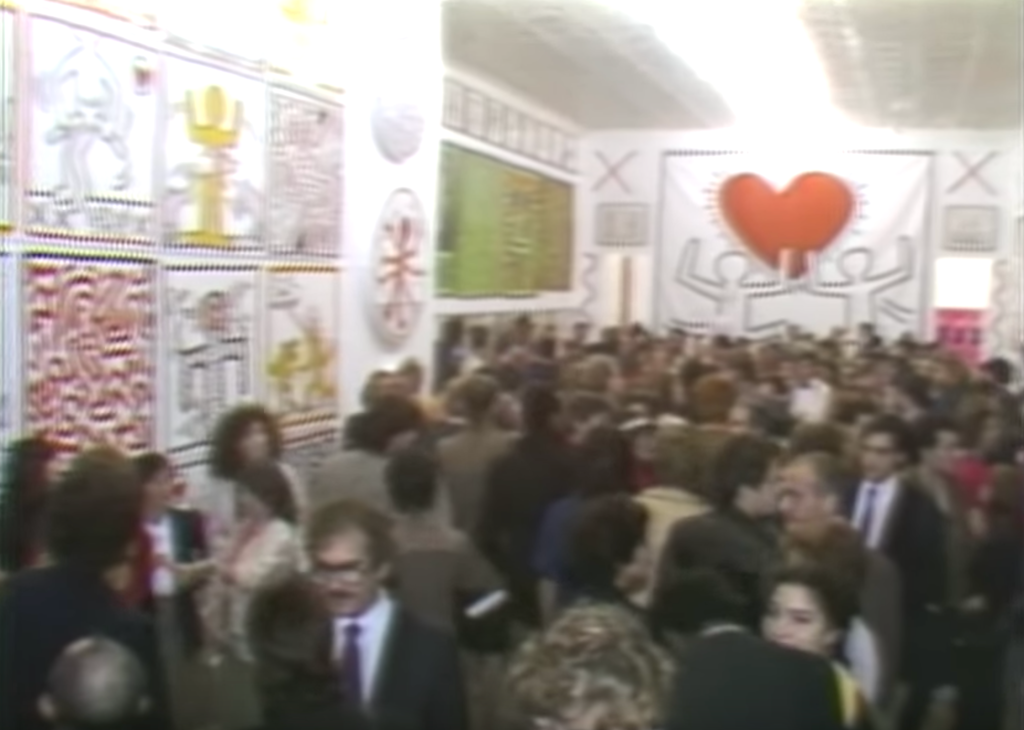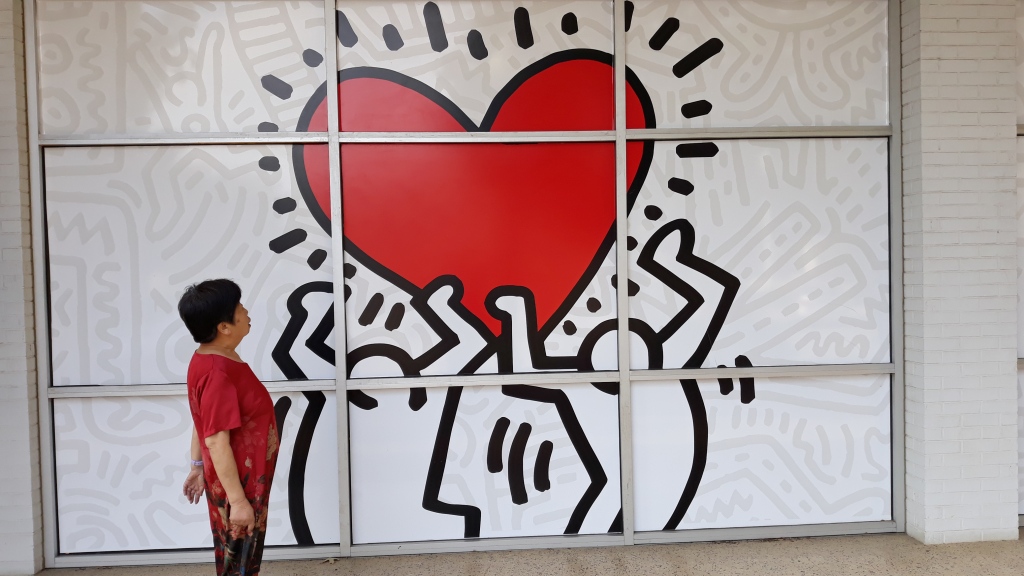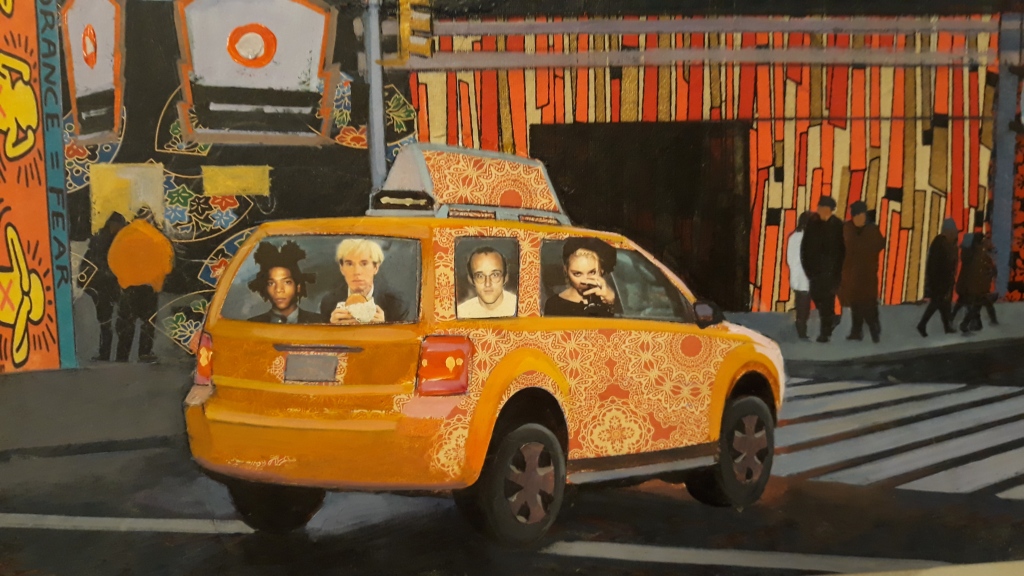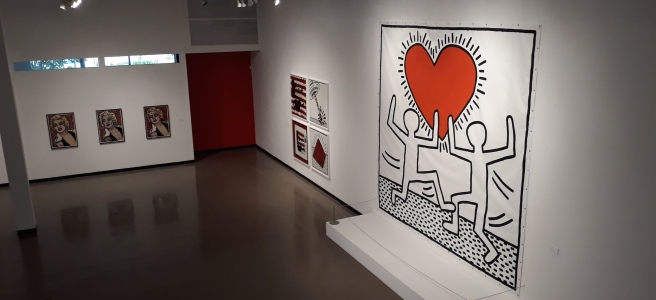In a news segment from the 1980s, Dan Rather refers to graffiti as something that is committed. As we know it, graffiti can be traced to 1960s Philadelphia, not so far from the Kutztown home of Keith Haring. He’s perhaps the artist best known for it. Graffiti would soon be taken on by artists in Haring’s future home of Brooklyn and New York City. Soon the city’s infrastructure would be covered in it.
The word may not have always referred to a crime, but by the 1980s graffiti was just as likely to refer to a style of art as a criminal act. That was an era when it was gaining acceptance and Haring’s outlines of babies, hearts and dogs were becoming a part of American Culture.

We’re a long way from the 1980s now, and Arlington, Texas is a long way from the gritty, urban east coast. But this is the location of my most recent encounter of Haring’s work.
It took us a while to make it out here. Some publications have referred to the Arlington Museum of Art as suburban, but the suburban-urban dichotomy isn’t as it was in the 80s, and in North Texas isn’t comparable to New York. Oddly, there is a grittiness and a happenstance feel to this capital of the “Mid-Cities,” while isn’t at all like New York, isn’t what we most associate with suburban either.
Instead of merely sterile, there is an eerie openness to this part of Arlington that makes you feel something interesting could emerge. The possibilities for such a thing are at least increased here in comparison to Downtown Dallas, Plano or Fort Worth. Arlington is a place that’s changing and becoming and doesn’t yet know what it will be.

Located on an old downtown strip, bypassed by newer and wider roads, the museum fills the void in a building that once housed a department store. We had been here on one prior occasion for a show of work by the amateur photographer Vivian Meyer. We knew about the Haring show, but it was an exhibit of work by artists from a group called the Fort Worth Art Collective that brought us here. The group of artists had latched onto the primary color in the exhibit and launched a show called “Red” which also mirrored Haring’s response to the AIDS crisis.

“Haring was in the right place and around all the right people,” my partner surmised. One of the works featured in the Red show depicts Haring, along with Basquiat, Warhol and Madonna looking out the rear of a taxi. Painted by Allison Proulx, that work is titled “Wish You Were Here.” I guess “here” doesn’t necessarily refer to Arlington.
I do like Keith Haring’s work, but I am probably more of a fan of the whole of the creation in 1980s New York than any one artist. It’s the energy of New York in that period I miss most. It’s something that only emerges and can’t be replicated.
While Haring would deal with AIDS, environmental degradation and other topics, he did so with a simple narrative. Many of Haring’s drawings are like pop songs I’ve heard too many times. They are good at capturing the zeitgeist, but artistically they are not very deep. They have a wonderful aesthetic quality and are nice to have around, but there’s no need to spend a lot of time with them.
“It’s better for me to ‘just do it’ and not fill in the blanks,” Haring said. “I don’t want to disclaim anyone’s idea about what it is and what it is not. Anyone’s idea is the right idea.”
After all, Haring got his start making quick chalk drawings in the New York subway. While he had art school training, he didn’t focus on what was thought of as fine or permanent art.
“I think it’s more important to make a lot of different things and keep coming up with new images and things that were never made before than to do one thing and do it well.”
But he did do one thing well, line drawing. Those figure drawings entered our cultural fabric more than perhaps even the work of Warhol. Someone I spoke with at the Arlington Art Museum mentioned how well Haring’s gift store items like pillows and t-shirts were selling. To me, that’s a testament to his permanence more than any museum show.
The work here normally resides at a museum in the artsy Wynwood part of Miami. It’s here thanks to a renovation project there. If you like Haring’s work, it looks great in this space. The experience may be like hearing a favorite pop song after a long absence. You might even bring home one of the cool items from the gift shop.
But take some time to learn more about the place and times of Keith Haring. The fact that he wanted to make things quickly without emphasis on perfection probably makes it more closely connected to a place and time than most art. No matter the definition of graffiti, what you are looking at is a purposeful, committed act. It could only have been produced by this guy from Kutztown, only in the 1980s and only in that wonderful, now lost, pre-corporatized New York.
Don’t forget to buy a t-shirt.
Discover more from Urban Art & Antiques
Subscribe to get the latest posts sent to your email.


